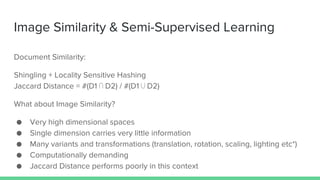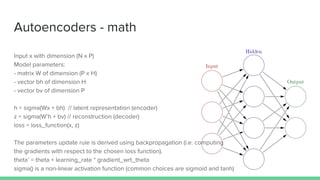Project - Deep Locality Sensitive Hashing
- 1. Data Mining Project By Gabriele Angeletti [email protected]
- 2. Image Similarity & Semi-Supervised Learning Document Similarity: Shingling + Locality Sensitive Hashing Jaccard Distance = #(D1 ⋂ D2) / #(D1 ⋃ D2) What about Image Similarity? ● Very high dimensional spaces ● Single dimension carries very little information ● Many variants and transformations (translation, rotation, scaling, lighting etc*) ● Computationally demanding ● Jaccard Distance performs poorly in this context
- 3. Locality Sensitive Hashing Main idea: hash points in buckets, such that the nearer two points are, the more likely they are to be hashed in the same bucket. Need a definition of “near”, and a function that maps “nearby” points to the same buckets. LSH Family H: set of function H that is (d1, d2, p1, p2)-sensitive. For points q,p: If D(p,q) < d1 then P(h(p) == h(q)) > p1 If D(p,q) > d2 then P(h(p) == h(q)) < p2 H: hash functions, D: definition of “near” (“far” actually). LSH problems: many hyper-parameters to fine-tune, computationally expensive
- 4. LSH Forest LSH index place each point p into a bucket with label g(p) = (h1(p), h2(p), . . . , hk(p)), g(p) is the k-digit label assigned to point p. LSH Forest, instead of assigning fixed-length labels to points, let the labels be of variable length; each label is made long enough to ensure that every point has a distinct label. A maximum label length km is imposed. The variable length label generation: let h1, h2, . . . , hkm be a sequence of km hash functions drawn independently and uniformly at random from H. The length-x label of a point p is given by g(p, x) = (h1(p), h2 (p), . . . , hx(p)). Ref: M. Bawa, T. Condie and P. Ganesan, “LSH Forest: Self-Tuning Indexes for Similarity Search”, WWW ‘05 Proceedings of the 14th international conference on World Wide Web, 651-660, 2005.
- 5. LSH Forest (cont.) LSH Tree: logical prefix tree on the set of all labels, with each leaf corresponding to a point. LSH Forest: composed of L such LSH Trees, each constructed with an independently drawn random sequence of hash functions from H. Query processing (m nearest neighbors of point p): Traversing the LSH Trees in two phases. In the first top-down phase, find the leaf having the largest prefix match with p’s label. x := maxl i{xi} is the bottom-most level of leaf nodes across all L trees. In the second bottom-up phase, we collect M points from the LSH Forest, moving up from level x towards the root. The M points are then ranked in order of decreasing similarity with p and returned.
- 6. LSH Forest - test setting Distance function: cosine distance LSHForest implementation: sklearn Hyper-parameters: default values of sklearn Accuracy metric for the k-th nearest neighbor: (p / data_len) p = 0 for each element in test set: If label(element) == label(k nearest neighbor of element) p++ This accuracy metric measures the ability of LSH Forest to retrieve elements of the same class.
- 7. LSH Forest - MNIST results Dataset: MNIST - handwritten digits grayscale image dataset. 28x28 pixels per image Training set - 50k images Test set - 10k images Dataset random samples: LSH Forest accuracy@k for k = 1, … , 50 neighbors Accuracy of ~95% for the first neighbor, drops to ~57% for the 50th neighbor.
- 8. LSH Forest - notMNIST results Dataset: notMNIST - grayscale images of letters from A to J in different fonts. 28x28 pixels per image Training set - 200k images Test set - 10k images Dataset random samples: LSH Forest accuracy@k for k = 1, … , 50 neighbors Accuracy of ~92% for the first neighbor, drops to ~70% for the 50th neighbor.
- 9. Can we do better? Idea: extract higher-level features with semantic meaning. How: Unsupervised Neural Networks (Autoencoders) ● LSH Forest took 784 feature vectors as input, treating each pixel like a feature ● Extracting higher-level features would: - compress the data - be computationally efficient (features << 784) - improve performance (comparisons done between features with semantic meaning rather than raw pixels)
- 10. Autoencoders Idea: Map input space to another space, and then reconstruct the original input from that space. The hope is that if the autoencoder is able to reconstruct the original input from a lower dimensional representation of if, it means that the representation has successfully captured important features in the input distribution. The mappings are linear in the model parameters (W, b), followed by a non-linearity, e.s. tanh(Wx + b). The loss function is usually the l2 loss (mean squared error) or the cross-entropy loss.
- 11. Autoencoders - math Input x with dimension (N x P) Model parameters: - matrix W of dimension (P x H) - vector bh of dimension H - vector bv of dimension P h = sigma(Wx + bh) // latent representation (encoder) z = sigma(W’h + bv) // reconstruction (decoder) loss = loss_function(x, z) The parameters update rule is derived using backpropagation (i.e. computing the gradients with respect to the chosen loss function). theta’ = theta + learning_rate * gradient_wrt_theta sigma() is a non-linear activation function (common choices are sigmoid and tanh)
- 12. Denoising Autoencoders Autoencoder variant trained to reconstruct the original input starting from a corrupted version of it (denoising task). Idea: If the autoencoder is able to reconstruct the input ( ) from a corrupted version of it ( ) we can expect that it must have captured robust features in the latent representation. Corruption method used - masking noise: a random fraction v of pixels is set to 0. Other possible methods: salt-and-pepper noise (fraction v flipped to minimum or maximum value), gaussian noise. x~ = noise(x) h = sigma(Wx~ + bh) // latent representation (encoder) z = sigma(W’h + bv) // reconstruction (decoder) loss = loss_function(x, z)
- 13. Stacked (Denoising) Autoencoders We can take the latent representation learned by an autoencoder, and use it as training data for a second autoencoder. In this way, we can create a stack of autoencoders, where each layer learns a higher-level representation of the input distribution with respect to the layer below it. It can be theoretically proved that adding a layer to the stack will improve the variational bound on the log probability of the data, if the layers are trained properly. This procedure is called unsupervised pre-training. Once the autoencoders are trained, we can construct the final architecture (deep autoencoder) and perform unsupervised fine-tuning of all the layers together.
- 14. Deep Autoencoder - visualize high-level features Visualization: t-distributed stochastic neighbor embedding (t-SNE) Left: t-SNE of the original MNIST (784 to 2), Right: t-SNE of the latent representation of a trained deep autoencoder (64 to 2)
- 15. Combine Deep Autoencoders with LSH Forest ● Deep Autoencoders extract high-level meaningful features (encodings) ● Encodings dimension is typically much lower than original dimension (data compression + computational efficiency) ● Similarity can be computed at the encodings level rather than pixel level (i. e. similarity between two high-level features (e.g. eyes) is much more meaningful than similarity between pairs of pixels ● This more powerful similarity detection algorithm can be used in semi- supervised settings (more on that later)
- 16. Deep Autoencoder + LSH Forest - MNIST - Deep Autoencoder architecture: 4 encoders - 784 → 2048 → 1024 → 256 → 64 4 decoders - 64 → 256 → 1024 → 2048 → 784 - LSH Forest ran on 64d encodings - Sample reconstructions of the model: LSH Forest accuracy@k for k = 1, … , 50 neighbors Similar accuracy for the first neighbors, +~35% deep autoencoder improvement for 50th neighbor
- 17. Deep Autoencoder + LSH Forest - notMNIST - Deep Autoencoder architecture: 4 encoders - 784 → 2048 → 1024 → 256 → 64 4 decoders - 64 → 256 → 1024 → 2048 → 784 - LSH Forest ran on 64d encodings - Sample reconstructions of the model: LSH Forest accuracy@k for k = 1, … , 50 neighbors Similar accuracy for the first neighbors, +~16% deep autoencoder improvement for 50th neighbor
- 18. Deep Autoencoder + LSH Forest - Query results MNIST: query image: , neighbors indexes: 1, 6, 12, 20, 27, 36, 50 Basic LSH (n. of 2: 17/50) Deep Autoencoder + LSH (n. of 2: 50/50) notMNIST: query image: , neighbors indexes: 1, 6, 12, 20, 27, 36, 50 Basic LSH (n. Of G: 7/50) Deep Autoencoder + LSH (n. Of G: 37/50)
- 19. Can we exploit better similarity techniques in semi-supervised settings? ● Big Data (unlabeled data >>>> labeled data) ● Supervised learning algorithms need labels ● Assumption: dataset with k% unlabeled data (say 98%) and j% labeled data (say 2%) ● Can we infer the labels of the 98% of the data using the labels we have for the 2%? ● Deep Autoencoder + LSH is totally unsupervised: we can use 100% of the data ● Idea: estimate the label of an item with the label of the most similar item for which we have the label
- 20. Two approaches First Found: Assign the label of the most similar item for which the label is known. Majority Voting: Assign the most frequent label between neighbors. The two results are nearly identical between the two approaches. Result: By knowing only 2750 / 55000 (5%) of the labels in the training set, we can infer the labels for the test set with a ~95% accuracy.
- 21. Two more metrics The average position of the first neighbor with known label decreases as the number of known labels increases. Thus, the more labels we know, the less neighbors we have to compute with LSH. The average number of not found elements with known label decreases as the number of known label increases. For this not found elements, a random label is chosen. Anyway, for just 5% of known labels, avg not founds are just 0.2.
- 22. Future work: ● Try majority voting weighted on distances ● Try convolutional autoencoders instead of denoising autoencoders (Huge expected improvement especially with images, provides translation and rotation invariance) ● Try with more complex datasets (e.g. CIFAR-10, 32x32 color images) ● Try the approach with other domains (e.g. sound, text, ...) ● Object similarity between domains (e.g. image of two similar to sound of person spelling “two”)





















